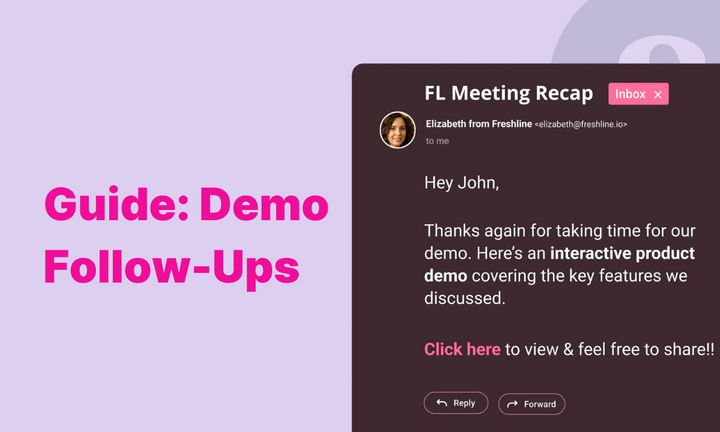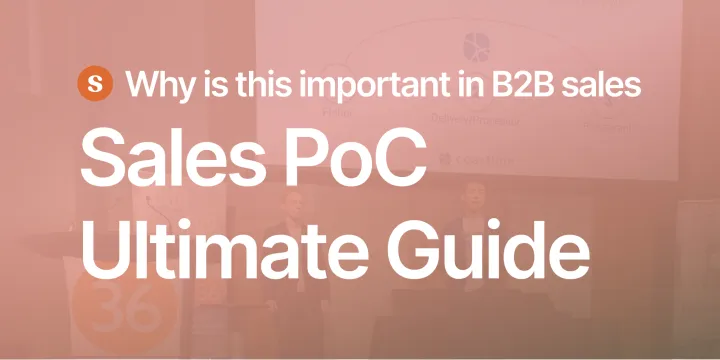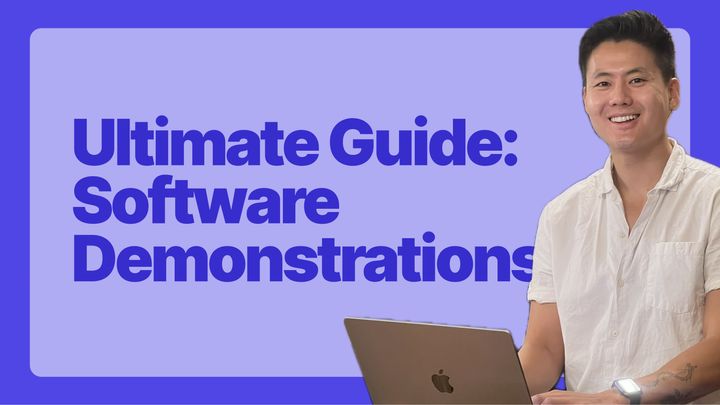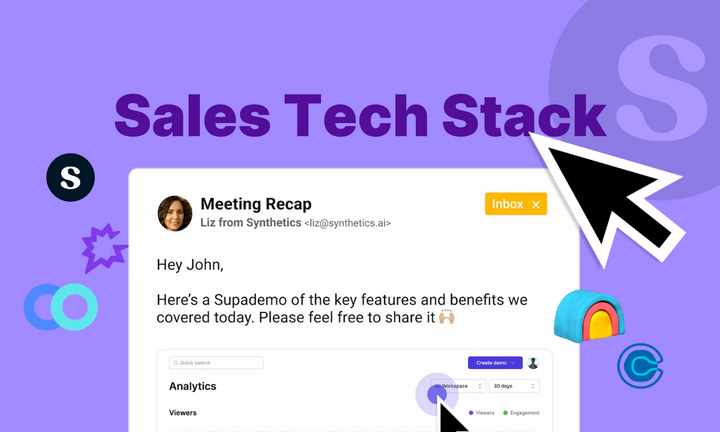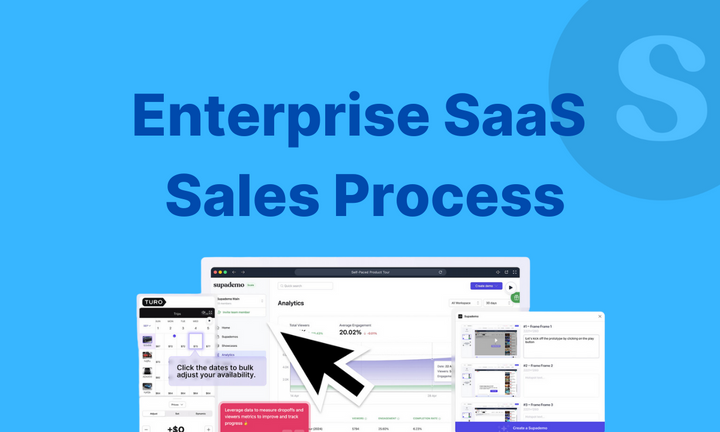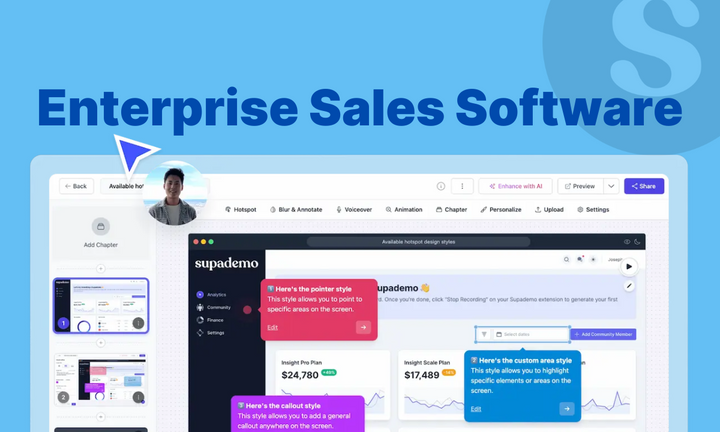After a product demo, your prospect understands who you are, what your product does, and how it might help.
But interest alone doesn’t close a deal.
The follow-up email is often the turning point.
It’s your chance to clarify the next steps, reinforce value, and make it easy for your prospect to move forward. But follow-ups often fall short—either too vague, too delayed, or too light on substance.
This guide breaks down how to avoid that.
We'll discuss when to follow up, how to tailor your message (with templates), and what to include to make your emails clear, actionable, and worth responding to.
What is a demo follow-up email?
A demo follow-up email is sent to a prospect after you've walked them through your product—whether live or recorded.
The goal of follow-up emails is to stay top-of-mind, reinforce the value proposition, and move them toward the next step.
These emails typically include:
- A thank you or personalized message
- Recap of the demo and key highlights
- Link to demo recording or interactive walkthrough
- Next steps or suggested actions
Why do demo follow-up emails matter?
This Reddit comment from four years ago still stands its ground.

Whether you're following up after a demo or circling back after radio silence, it's almost always a good move—and for good reason.
1. The competition is fierce. Your prospect likely isn’t evaluating your product in a vacuum. They’re sitting through multiple demos, comparing vendors, and juggling priorities. If you don’t follow up, you risk slipping off their radar, leaving room for a competitor to take your place.
2. B2B sales cycles are long by nature. They often require multiple touchpoints, layers of stakeholder input, and plenty of internal discussion. A well-timed follow-up keeps you top of mind and makes it easier for your prospect to keep the deal moving internally.

In short, a thoughtful follow-up helps you stay relevant, build trust by sharing helpful resources, and reduce friction in a complex buying journey.
12 situations where follow-up emails seal the deal (with templates)
Following up is an art, and if you do it right and at the right time, it can turn the decision in your favor.
Here are 12 types of follow-ups you can do with your prospects and at what time.
1. Post-demo follow-up email
When to send: Within 5-10 minutes of the demo
Use your post-demo follow-up email to maintain momentum and stay connected with your prospect.
Hi [Prospect’s Name],
Thanks again for joining the demo! I really enjoyed our conversation and learning more about [Company Name]'s goals.
Here’s a quick recap of what we covered:
- [Feature] — to solve [Pain Point]
- [Use Case] — enabling [Outcome]
- [Next Step] — e.g., sending a custom proposal or scheduling a technical deep dive
I’ve also shared an [interactive demo link] that highlights the key features we discussed. Feel free to explore it or forward it to your team.
Looking forward to our next chat on [agreed date]!
[Your Name]
2. Free trial follow-up
When to send: 2 days before the trial ending date or after 1 day the trial has ended
Free trial users have already explored your product firsthand, which makes them far more likely to convert—if you engage them at the right time.
Sending the Follow-Up Emails Before the Trial Ends
Reaching out before the trial ends gives you the chance to:
- Remind users of the upcoming renewal
- Reinforce the value they’ve already seen
- Prompt them to take the next step while interest is still high
A well-timed free trial email can reduce drop-offs and turn curious users into paid ones.
Hi [Name],
Hope you're enjoying [Product Name]!
Here’s what you’ve achieved so far:
- [X reports created]
- [Y hours saved using automation]
Your trial ends in [X days]. To keep things running smoothly, you can upgrade now and keep your progress.
Bonus: we’re offering a [10% discount / extended trial] as a thank you.
[CTA Button]
Let me know if you have any questions!
Best,
[Your Name]
Sending the Follow-Up Emails After the Trial Ends
Once the trial ends, your follow-up emails should gently re-engage the user and remind them of what they’re missing. The goal is to create urgency—without pressure—by reinforcing the value they experienced and offering a clear next step.
Hi [Name],
Your trial of [Product] just ended—but we’d love to help you pick up right where you left off.
During your trial, you:
- [Streamlined X process]
- [Achieved Y result]
Want to keep going? Reactivate your account below.
[CTA]
Best,
[Your Name]
I loved PandaDoc after the free trial follow-up emails. It’s entirely benefit-focused and shares impressive numbers to nudge me to buy.
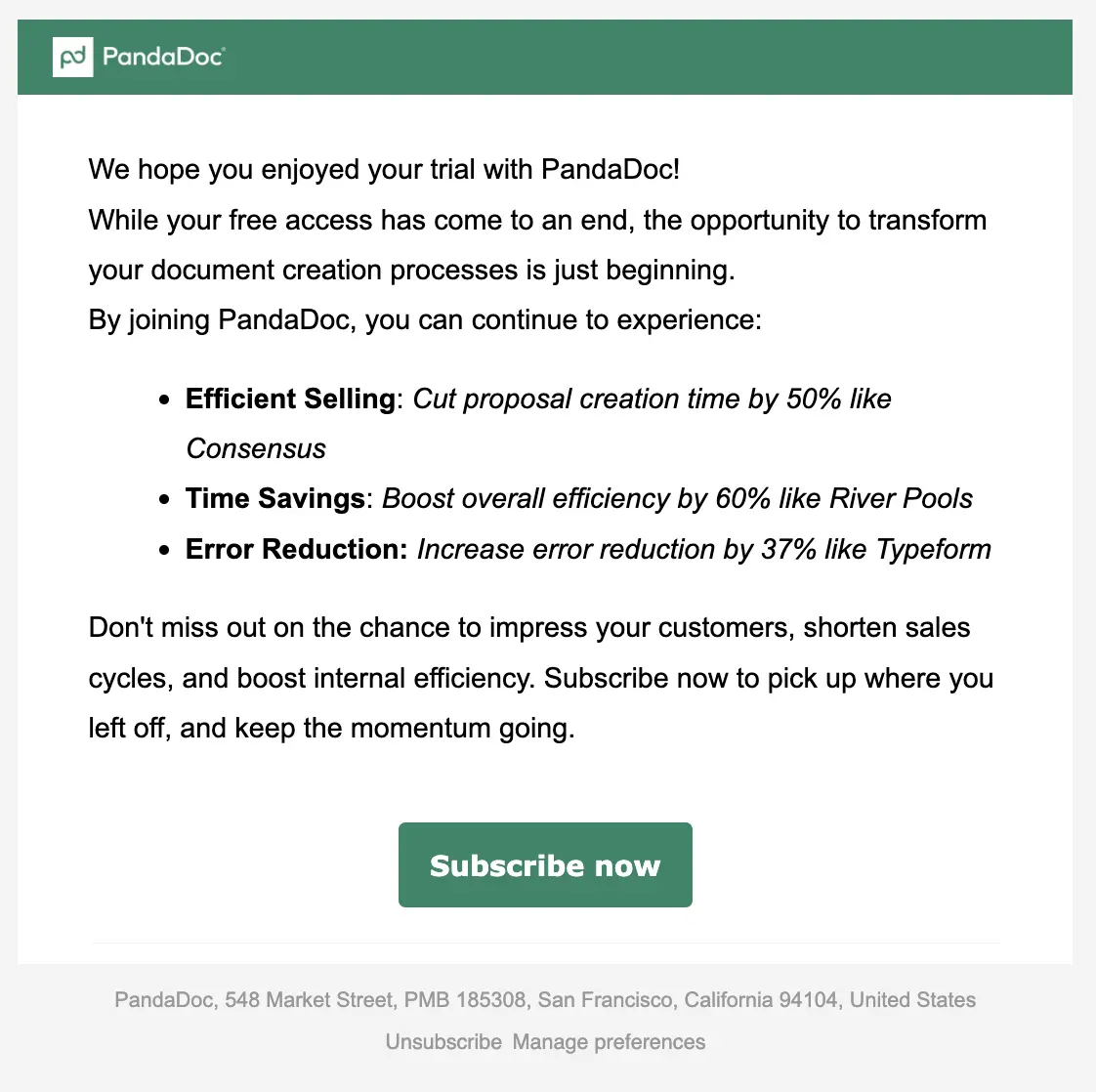
3. Product roadmap follow-up
When to send: Within hours of the user asking about a potential upgrade
When a prospect asks about upcoming features, whether during the demo or in a quick message afterward, it’s best to follow up immediately with your roadmap details.
Hi [Name],
Thanks for asking about [Feature]. You’ll be happy to know it’s on our roadmap for [Q3/next month/etc.].
We’ll notify you as soon as it goes live, but here’s a sneak peek: [link to roadmap/short interactive demo walkthrough].
4. Feature request follow-up
When to send: Monthly or milestone-based
Keep prospects in the loop on the progress of any feature they request. Let them know you’ve taken their input seriously and are actively working on it. It builds trust, shows accountability, and reinforces your commitment to their needs.
Hi [Name],
Just wanted to share a quick update: our team has started working on the [requested feature] you mentioned. We’ll keep you in the loop once it’s ready for beta!
Thanks for shaping our product with your ideas.
5. Feedback request follow-up
When to send: After trial, onboarding, or support experience
Feedback request follow-up emails are best to gather direct insights from prospects or customers while also reinforcing that their opinions matter.
When done thoughtfully, they not only inform product improvements but also strengthen the relationship by showing you genuinely care about their experience.
Hi [Name],
Hope you’re doing well!
I wanted to quickly check in and see how your experience with [Product/Service Name] has been. Your feedback really helps us improve and make things even better for you.
[Link to feedback form or 2-question poll]
If you could spare just a few minutes to share your thoughts, I’d really appreciate it! Here’s the link: [Feedback Link]
Thanks a bunch!
[Your name]
6. Proposal email follow-up
When to send: 2–3 days after sending the proposal
A well-timed proposal follow-up email gives you a valuable opportunity to address any concerns—whether related to the proposal itself or internal stakeholder alignment—that might be slowing down the decision process.
Hi [Name],
Just checking in to see if you had a chance to review the proposal. Happy to hop on a call to walk through details or answer questions.
Looking forward to hearing your thoughts.
7. Consultative follow-up
When to send: A few days after a call or meeting, especially when you discuss specific challenges or goals.
As a sales rep, your role goes beyond pitching a product—you’re selling a solution, not just a product. Consultative follow-up emails are a chance to reinforce that. They let you revisit challenges discussed during the demo, offer helpful resources, and build genuine rapport by showing you’re invested in their success.
Hi [Prospect’s Name],
I’ve been thinking about our conversation regarding [mention challenge or goal], and I wanted to share a resource that might be helpful: [Link/Document].
It covers [briefly describe content], which aligns with your objectives and could offer some fresh ideas.
Let me know if you’d like to discuss this further or need help with any part of your strategy.
Best,
[Your Name]
8. Technical issues follow-up
When to send: Immediately after resolving, and again 2-3 days later
Following up after a technical fix shows accountability, builds trust, and reinforces that you’re not just solving problems—you’re supporting users' success every step.
Hi [Name],
I wanted to confirm that [technical issue] is fully resolved. If anything still feels off, let me know and we’ll jump on it right away.
Your experience means a lot to us.
9. Stakeholder alignment follow-up email
When to send: When decision-making is stalled due to missing stakeholders
Send stakeholder alignment follow-up emails to ensure all key decision-makers are involved.
Whether you're early in the conversation or further along in the consideration stage, looping in stakeholders early helps streamline the process and avoid delays later on.
Hi [Name],
Would it be helpful to a joint call with your [CFO, CTO, etc.]? I can walk them through a tailored version of the demo and answer questions relevant to their role.
10. No-show follow-up
When to send: Within 30 minutes of missed meeting
Not every call goes as planned. It's not uncommon for prospects to miss a meeting.
A polite no-show follow-up email helps you re-engage, check if they’re still interested, and offer to reschedule in case something personal comes up.
Hi [Name],
Looks like something came up. Totally understand.
Here’s a link to reschedule at your convenience: [calendar link].
11. Contract finalization follow-up
When to send: 4-5 days after sending the contract
It’s common for prospects to take time before responding to contracts—especially when internal reviews are involved.
Follow-up emails can gently remind them to review and sign while reassuring them that you’re available to answer any questions before they move forward.
Hi [Name],
I wanted to follow up on the contract I sent last week. If you have any questions or need further clarifications, I’m here to help.
Also, if there’s anything holding up the decision on your end, just let me know—I’m happy to assist in any way I can.
Looking forward to finalizing things with you!
Best,
[Your name]
12. Renewal or upgrade follow-up
When to send: 2–3 weeks before expiration or right after launching new features.
Renewal follow-up emails serve as timely nudges encouraging users to renew their plan and continue seeing value from your product.
If you’ve recently launched new features or improvements, this is also a great opportunity to highlight what’s new and keep customers engaged.
Hi [Name],
Your current plan is ending soon, and we’ve just launched some exciting updates:
- [Feature 1]: [Value it offers]
- [Feature 2]: [Specific outcome it drives]
Happy to walk you through them!
How to write high-converting demo follow-up emails: Key elements to consider
1. Make the subject line catchy and relevant
Writing subject lines for follow-up emails is surprisingly straightforward—if you anchor them in context and clarity.
Ask yourself: What is the point of this follow-up? Is the trial ending soon? A recap? An offer? Your subject line should reflect that directly.
For example:
- "Your trial is ending soon."
- "Recap from today’s demo."
- "Let’s finalize the next steps."
These subject lines work because they’re timely, relevant, and useful.
Make them more noticeable using the recipient’s name or company (See PandaDoc and Avochato’s subject line below).
Something like:
- "[First Name], here’s what we discussed today."
- "Next steps for [Company]'s workflow upgrade."

2. Personalize beyond “hey {first name}”
Go deeper than just auto-filling names.
Tap into previous conversations with prospects or pull data from your CRM. You can also reference a specific challenge they mentioned during demo call, a goal they emphasized, or a question they asked. Such a level of attention helps bridge the gap between previous communications and make your emails stand out.
A thoughtful personalized email can look like this:
Hi [Name],
It was great connecting earlier. I’ve been thinking about how [Your Product] could help your team automate those manual reports you mentioned and free up hours each week.
3. Recap the demo highlights
Don’t rehash the entire demo in your follow-ups.
Instead, distill the 1–2 biggest takeaways directly related to their pain points.
You can also go beyond static recall and share an interactive version of the demo they saw. That way, prospects can play around with the features they care about and share them with other decision-makers.
Supademo makes it easy to build and share such demos. We have written an entire guide on how to build engaging interactive product demos. Check it out!
And the best part? You can personalize the demo link and text based on the recipient's company or name.
4. Address unanswered questions or objections
Even if the call felt like a slam dunk, there are always objections lurking in the background.
Budget constraints, integration fears, or concerns about onboarding can block your deal.
Use the follow-up emails to bring those hesitations to light and answer them.
Remember, you’re not merely a salesperson but also a trusted advisor to your buyers.
5. Share resources that move the deal forward
Your follow-up emails should feel like a continuation of your conversation—not a sales script.
One of the best ways to keep the momentum is by offering something genuinely useful. Such resources can be in any form:
- A case study featuring a similar company
- An ROI calculator based on their use case
- A short video demo of a key workflow
- A pricing comparison vs. a competitor they mentioned
6. Include one clear, action-oriented CTA
It’s tempting to get overboard with follow-up email CTAs.
Check out the case study. Book a consultation call. Sign up for a free trial. It’s enticing to add multiple CTA. But, it can backfire. You might end up diluting the message’s focus and confusing the reader.
So, focus on a single action.
Depending on where they are in the journey, that CTA might be:
- Book a 15-minute call to finalize the details
- Start your free trial now
- Review the custom proposal here
- Share this interactive demo with your team
How to keep track of your demo follow-up emails
Use the following tactics to monitor your email follow-up strategy performance and make necessary changes.
Use your CRM or sales engagement platform
Log every follow-up as a structured activity:
- Include the date/time of the email sent
- Note the type (e.g., post-demo, proposal, roadmap update)
- Record the stage of the deal
Use sales tools like HubSpot, Salesforce, Close, or Outreach allow you to automate this process, set reminders, and even tag email templates by follow-up type.
Look for the following key metrics to assess how well your follow-up email strategy is performing.
A/B test for data-backed insights
Improve the performance of your follow-up emails by testing different elements of it—Subject line, CTAs, timings, email opening, etc.
📍 Subject lines:
- Emojis vs. non-emoji.
- One word vs. five words
📍Email structure: Try a short version with just bullets vs. a longer, consultative recap.
📍CTA placement or type:
- “Book a strategy call” vs. “Try it out yourself”
- Button vs. plain link
📍Resource inclusion: Include a case study in one version and a Supademo link in the other.
Select the testing ample group and run the test until you have statistically significant numbers to analyze different versions.
Collect user feedback
Use both passive and active feedback to improve future follow-ups:
- Passive: You can find this information in your CRM or email automation platform. Look for engagement patterns and click rates to assess the performance.
- Active: Ask directly—“Was this follow-up helpful?” or “Is there anything you'd like to see in our emails that we missed?
Conclusion
A thoughtful, timely follow-up email can turn demo interest into real momentum.
By personalizing your message, offering helpful resources, and clearly guiding the next step, you make it easier for your prospect to move forward with confidence.
If you’re looking to make your follow-up emails even more impactful, try adding an interactive product demo that prospects can explore and share internally.
Supademo makes it incredibly easy to build and embed these walkthroughs. Create your first Supademo walkthrough and turn every follow-up into a closed deal.


